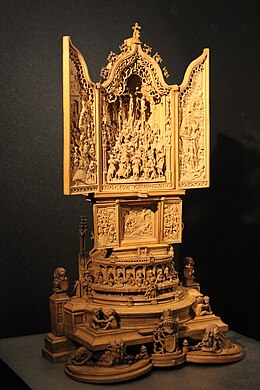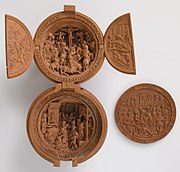171:
187:
199:
22:
573:
94:
of workshops were likely involved in their production. That a majority of the miniatures share technical, stylistic and thematic similarities, they are often considered as a near homogeneous group. This view was first noted by the art historian Jaap
Leeuwenberg, who cited such stylistic traits as broad and densely populated animated scenes, which are often placed, in the words of the art historian William Wixom, on "steeply angled ground planes of tiled floors".
77:, or a patron. Dircksz is thought to have been active between 1500 and 1530, and responsible for some sixty of the surviving examples. He may have led a workshop in the southern Netherlands, given that Flemish inscriptions appear on some of the carvings. Alternatively, it was located more northerly, possibly in
93:
The more complex boxwood miniatures may have taken decades of work to complete, over a period equivalent to the entire career of a medieval master carver. Thus, production must have been organised between workshops of specialised artisans, and because the works are so intricate, only a small number
105:, approaches and use of depth, as well as similar hinges and methods of construction, the art historian Jaap Leeuwenberg suggests that production of a number of the miniatures was overseen by a single master named Adam Dircksz. Dircksz was first identified through a signature on a
97:
Other shared features include spatial devices, figures in contemporary dress, and draperies arranged in angular folds. On this basis
Leeuwenberg attributed a large number of the objects to Dircksz, around 35–40, although that estimate has been revised down in more recent years.
126:
The Latin name "Adam
Theodrici" may be translated into English as "Adam of Theodoric", but art historians usually use the Dutch version of his name, Adam Dircksz. Although it was rare in the 16th century for artists to sign a work, when done, it usually took the
186:
170:
158:
around 1500", but points out that "giant strides are rarely made in art history", pointing to affinities with silversmith's art, especially the miniature architectural elements often found in ecclesiastical silver and ornaments.
72:
Almost nothing is known about his life, except from some dates and signatures left on carvings, which indicate only that he was associated with the art works, the real life person may have been a woodcutter, sculptor,
198:
147:
Regardless of the number of works that
Dircksz or his workshop can be attributed with, art historians often debate what the artistic and technical precedents for the miniatures might be. Dutch art historian
530:
348:
609:
633:
537:
603:
57:. It may be that the master was the innovator in this style of sculpture, and that similar works were directly inspired. According to the
452:
Boehm, Barbara Drake; Suda, Alexandra. "Handpicked: Collecting
Boxwood Carvings from the Sixteenth to the Twenty-First Centuries." In:
236:
639:
249:
621:
489:
468:
666:
523:
85:
in
Holland. In any case, apart from Henry VIII and Catherine, all of the original owners come from the Netherlands.
192:
Prayer Bead with the
Crucifixion and Jesus before Pilate (open), c. 1500–1530. Metropolitan Museum of Art, New York
53:
micro-carvings. Other historians prefer to attribute various unrelated artists who are given individual or grouped
671:
615:
456:(ed), "Small Wonders: Late-Gothic Boxwood Micro-Carvings from the Low Countries". Amsterdam: Rijksmuseum, 2016.
627:
62:
254:
177:
676:
546:
142:
50:
26:
49:
sculptor whose workshop is often attributed with the creation of around 60 of the c. 150 extant
661:
8:
388:
418:
431:
102:
485:
464:
154:
152:
observes how, to a large extent, it seems "as if this exquisite sculpture was born
61:, Dircksz may have served "elite patrons in the circle of the Holy Roman Emperor
349:
Investigating
Miniature Boxwood Carving at the Art Gallery of Ontario in Toronto
460:
453:
149:
110:
58:
42:
31:
655:
78:
463:. "Small Wonders: Gothic Boxwood Miniatures". Art Gallery of Ontario, 2016.
572:
515:
46:
21:
435:
205:
204:
Prayer nut case with tracery, attributed to Adam
Dircksz, c. 1500–1530.
587:
106:
473:
Scholten, Frits. "A Prayer Nut in a Silver
Housing by 'Adam Dirckz'".
74:
54:
610:
Prayer bead with the Adoration of the Magi and the Crucifixion
634:
Prayer bead with the Prayer of the Rosary and the Lamentation
389:
Prayer Bead with the Crucifixion and Jesus Carrying the Cross
82:
66:
101:
Because of shared characteristics, including common use of
176:
Prayer Bead with the Crucifixion and Jesus before Pilate.
509:
484:. Ann Arbor, MI: Antique Collectors Club Limited, 2000.
351:". CODART eZine, Spring 2003. Retrieved 18 November 2018
133:" (made me) form, in effect of making the object speak.
432:
Triptych, Adam Dircksz (workshop of), c. 1500 – c. 1530
391:". Metropolitan Museum of Art. Retrieved 8 October 2018
30:, dated 1511. 25.1 cm × 14 cm (9.9 in × 5.5 in).
498:, volume 61, no. 1/2, Summer 1983. pp. 38–45
494:Wixom, William. "A Brabantine Boxwood Triptych".
653:
41:(active 1500–1530) is the name ascribed by some
531:
239:". British Museum. Retrieved 18 November 2018
545:
622:Miniature altarpiece, Victoria & Albert
482:Netherlandish Art in Rijksmuseum: 1400–1600
128:
114:
538:
524:
477:, volume 59, no. 4, 2011. pp. 322–347
640:Miniature altarpiece with the Crucifixion
496:Bulletin of the Detroit Institute of Arts
20:
258:, 12 May 2017. Retrieved 8 October 2018
16:Dutch sculptor (active c. 1500–c. 1530)
654:
341:
325:
323:
519:
360:Van Os; Filedt Kok (2000), pp. 107–08
268:
266:
264:
231:
229:
227:
225:
223:
628:Miniature altarpiece, British Museum
480:Van Os, H.W.; Filedt Kok, Jan Piet.
403:
363:
332:
320:
311:
284:
275:
237:Adam Dircksz (Biographical details)
13:
604:Adoration of the Magi (altarpiece)
302:
293:
261:
220:
14:
688:
503:
242:
571:
197:
185:
169:
424:
412:
394:
381:
372:
354:
347:Suda, Alexandra; Ellis, Liza. "
88:
1:
616:Miniature altarpiece, Louvre
255:The New York Review of Books
7:
438:. Retrieved 25 October 2019
10:
693:
445:
378:Scholten (2017), pp. 24–36
250:The Universe in a Nutshell
178:Metropolitan Museum of Art
162:
140:
596:
580:
569:
553:
308:Ellis; Suda (2016), p. 73
299:Ellis; Suda (2016), p. 28
667:Gothic boxwood miniature
547:Gothic boxwood miniature
512:, Art Gallery of Ontario
475:The Rijksmuseum Bulletin
213:
143:Gothic boxwood miniature
136:
121:Adam Dircksz has made me
65:, with a strong link to
51:Gothic boxwood miniature
45:to a highly influential
329:Scholten (2011), p. 339
317:Anderson (2012), p. 112
281:Scholten (2011), p. 342
116:Adam Theodrici me fecit
27:Portable altar (WB.232)
409:Scholten (2017), p. 31
400:Scholten (2017), p. 32
338:Scholten (2017), p. 27
129:
115:
35:
672:Renaissance sculptors
113:Copenhagen, reading "
24:
369:Marks (1977), p. 142
290:Marks (1977), p. 141
79:the north of Brabant
510:The Boxwood Project
272:Wixom (1983), p. 43
36:
649:
648:
490:978-9-0400-9376-0
469:978-1-8942-4390-2
684:
575:
540:
533:
526:
517:
516:
439:
428:
422:
416:
410:
407:
401:
398:
392:
385:
379:
376:
370:
367:
361:
358:
352:
345:
339:
336:
330:
327:
318:
315:
309:
306:
300:
297:
291:
288:
282:
279:
273:
270:
259:
246:
240:
233:
201:
189:
173:
132:
118:
692:
691:
687:
686:
685:
683:
682:
681:
677:Dutch sculptors
652:
651:
650:
645:
592:
576:
567:
555:
549:
544:
506:
501:
461:Suda, Alexandra
454:Scholten, Frits
448:
443:
442:
429:
425:
417:
413:
408:
404:
399:
395:
386:
382:
377:
373:
368:
364:
359:
355:
346:
342:
337:
333:
328:
321:
316:
312:
307:
303:
298:
294:
289:
285:
280:
276:
271:
262:
248:Shaw, Tamsin. "
247:
243:
234:
221:
216:
209:
202:
193:
190:
181:
174:
165:
145:
139:
91:
17:
12:
11:
5:
690:
680:
679:
674:
669:
664:
647:
646:
644:
643:
642:, early 16th c
637:
636:, early 16th c
631:
625:
619:
618:, c. 1500-1520
613:
607:
606:, c. 1500–1530
600:
598:
594:
593:
591:
590:
584:
582:
578:
577:
570:
568:
566:
565:
559:
557:
551:
550:
543:
542:
535:
528:
520:
514:
513:
505:
504:External links
502:
500:
499:
492:
478:
471:
457:
449:
447:
444:
441:
440:
423:
421:on MET website
411:
402:
393:
380:
371:
362:
353:
340:
331:
319:
310:
301:
292:
283:
274:
260:
241:
218:
217:
215:
212:
211:
210:
203:
196:
194:
191:
184:
182:
175:
168:
164:
161:
150:Frits Scholten
141:Main article:
138:
135:
111:Statens Museum
90:
87:
59:British Museum
43:art historians
32:British Museum
15:
9:
6:
4:
3:
2:
689:
678:
675:
673:
670:
668:
665:
663:
660:
659:
657:
641:
638:
635:
632:
629:
626:
623:
620:
617:
614:
611:
608:
605:
602:
601:
599:
595:
589:
586:
585:
583:
579:
574:
564:
561:
560:
558:
552:
548:
541:
536:
534:
529:
527:
522:
521:
518:
511:
508:
507:
497:
493:
491:
487:
483:
479:
476:
472:
470:
466:
462:
459:Ellis, Lisa;
458:
455:
451:
450:
437:
433:
427:
420:
415:
406:
397:
390:
384:
375:
366:
357:
350:
344:
335:
326:
324:
314:
305:
296:
287:
278:
269:
267:
265:
257:
256:
251:
245:
238:
232:
230:
228:
226:
224:
219:
207:
200:
195:
188:
183:
179:
172:
167:
166:
160:
157:
156:
151:
144:
134:
131:
124:
122:
117:
112:
108:
104:
99:
95:
86:
84:
80:
76:
70:
68:
64:
60:
56:
52:
48:
44:
40:
33:
29:
28:
23:
19:
563:Adam Dircksz
562:
495:
481:
474:
426:
414:
405:
396:
383:
374:
365:
356:
343:
334:
313:
304:
295:
286:
277:
253:
244:
153:
146:
125:
120:
103:horror vacui
100:
96:
92:
71:
39:Adam Dircksz
38:
37:
25:
18:
662:Woodcarvers
624:, 1500-1520
612:, 1500-1510
588:Prayer nuts
554:Artists and
436:Rijksmuseum
208:, Amsterdam
206:Rijksmuseum
109:now in the
89:Attribution
656:Categories
419:17.190.474
180:, New York
107:prayer nut
556:workshops
155:ex nihilo
75:medallist
63:Charles V
130:me fecit
55:notnames
34:, London
581:Formats
446:Sources
163:Gallery
630:, 1511
488:
467:
81:or at
597:Works
214:Notes
137:Style
83:Delft
67:Delft
47:Dutch
486:ISBN
465:ISBN
434:".
252:".
123:).
119:" (
69:."
658::
322:^
263:^
222:^
539:e
532:t
525:v
430:"
387:"
235:"
127:"
Text is available under the Creative Commons Attribution-ShareAlike License. Additional terms may apply.



